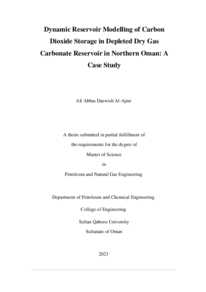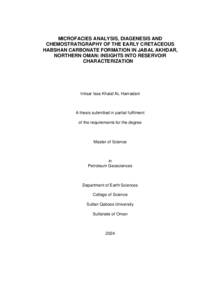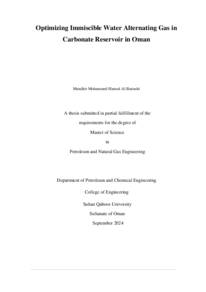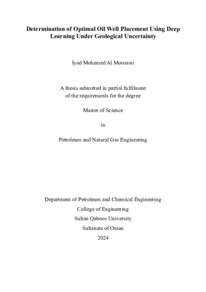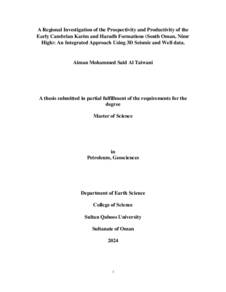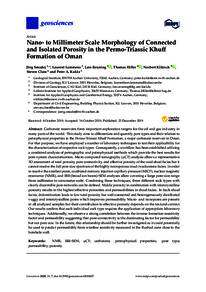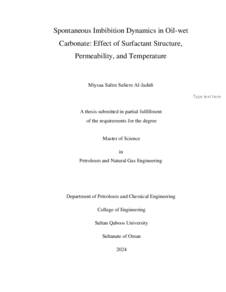Document
Dynamic reservoir modelling of carbon dioxide storage in depleted dry gas carbonate reservoir in Northern Oman : a case study.
Source
Master's thesis
Country
Oman
City
Muscat
Publisher
Sultan Qaboos University
Gregorian
2023
Language
English
Thesis Type
Master's thesis
English abstract
Carbon capture, utilization, and storage (CCUS) is considered as one of the important
and essential technologies that needs to be addressed in order to reduce the different
anthropogenic greenhouse gases (GHGs) emissions in the atmosphere especially
carbon dioxide (CO2) that mainly comes from industry and fossil fuels. Over the last
few decades, the GHGs emission have shown an increasing trend worldwide. This in
turn affects the global temperature and threatens the lives of organisms. Therefore,
CCUS is considered as an emerging technology that requires an in-depth investigation
to ensure safe and large- scale sequestration of the anthropogenic CO2. Underground
storage areas have been suggested by scientists and researchers for CO2 storage.
Depleted gas reservoirs are one of the suggest options for atmospheric CO2 storage to
mitigate the level of the anthropogenic CO2. However, inside these reservoirs, various
trapping mechanisms take place and therefore require thorough investigation. This
study aims to investigate the impact of different parameters like connate water
saturation, permeability and wettability on physical trapping mechanisms in a carbonate
gas reservoir. In addition, effect of Henry’s law constant and salinity on the chemical
trapping mechanisms were studied as well. A 3D RFD tNavigator simulator was used
to investigate the impact of the various parameters on the CO2 trapping mechanisms.
The results showed that for the physical trapping mechanism, as the connate water
saturation increases the amount of CO2 stored in the depleted gas reservoir increases
with time. A decrease in the reservoir permeability, increases the amount of CO2 that
can be trapped in the reservoir by the action of capillary forces. In addition, as the rock
becomes more water-wet, more CO2 is retained in the reservoir.
As for the chemical trapping mechanism, the solubility of CO2 in water increases when
Henry’s law constant decreases while keeping other factors constant. More CO2 will be
soluble in brine with time and hence higher amount of CO2 will be trapped. In addition,
increasing brine salinity decreases the CO2 solubility in brine. The findings of this study
provide an insight on the feasibility of CO2 storage in depleted gas reservoir. The results
also indicate that tNavigator software is capable of modelling CO2 storage in such
storage systems.
The results obtained from simulation clearly indicate that, RFD tNavigator was able to
successfully predict the behaviors and performance of injected CO2 for storage
purposes of CO2 inside depleted gas reservoirs.
Arabic abstract
يعتبر احتجاز الكربون واستخدامه وتخزينه أحد التقنيات المهمة والأساسية التي يجب توجيهها من أجل تقليل انبعاثات الغازات الدفيئة البشرية المنشأ من الغالف الجوي وخاصة انبعاثات ثاني أكسيد الكربون الذي يأتي بشكل رئيسي من الصناعة والوقود االحفوري. وقد أظهرت انبعاثات الغازات الدفيئة اتجاها متزايدا خلال العقود القليلة الماضية في العالم. وهذه بدورها تؤثر على درجة الحرارة العالمية وتهدد حياة الكائنات الحية. لذلك، تعتبر تكنولوجيا احتجاز ثاني أكسيد الكربون وتخزينه بمثابة تكنولوجيا ناشئة تتطلب تحقيقا متعمقا لضمان عزل آمن وواسع النطاق لثاني أكسيد الكربون الناتج عن األنشطة البشرية. وقد اقترح العلماء والباحثون مناطق تخزين تحت األرض لتخزين ثاني أكسيد الكربون. تعد مكامن الغاز الناضبة إحدى هذه الخيارات المقترحة لتخزين ثاني أكسيد الكربون الموجود في الغالف الجوي للتخفيف من مستوى ثاني أكسيد الكربون الناتج عن األنشطة البشرية. يتم احتجاز ثاني أكسيد الكربون داخل هذة المكامن، بآليات مختلفة، والتي تتطلب دراسة شاملة. تهدف هذه الدراسة إلى دراسة تأثير عوامل مختلفة مثل تشبع الماء والنفاذية وقابلية البلل وتأثير ثابت قانون هنري والملوحة على آليات احتجاز ثاني أكسيد الكربون في خزان غاز كربوني. تم استخدام برنامج محاكاة ثلاثي األبعاد (tNavigator ( للتحقيق في تأثيرات هذه العوامل المختلفة على آليات احتجاز ثاني أكسيد الكربون. أظهرت النتائج أنه بالنسبة آلليات االحتجاز المادية، حيث يزيد تشبع الماء المتراكم من كمية ثاني أكسيد الكربون المخزنة في مكمن الغاز الناضب مع مرور الوقت. كذلك يؤدي انخفاض نفاذية الخزان إلى زيادة كمية ثاني أكسيد الكربون التي يمكن احتجازها في المكمن بفعل القوى الشعرية. باإلضافة إلى ذلك، عندما تصبح الصخور أكثر رطوبة بالمياه، يتم االحتفاظ بمزيد من ثاني أكسيد الكربون في المكمن. كما هو الحال بالنسبة آلليات االحتجاز الكيميائي، تزداد قابلية ذوبان ثاني أكسيد الكربون في الماء عندما ينخفض ثابت قانون هنري مع الحفاظ على ثبات العوامل األخرى. سيكون المزيد من ثاني أكس للذوبان في يد الكربون قابالً الماء المالح مع مرور الوقت، وبالتالي سيتم احتجاز كمية أكبر من ثاني أكسيد الكربون. باإلضافة إلى ذلك، فإن زيادة ملوحة المحلول الملحي بالمكمن تقلل من قابلية ذوبان ثاني أكسيد الكربون في المحلول الملحي بالمكمن. تشير نتائج هذه الدراسة إلى جدوى استخدام خزان الغاز الناضب ألغراض تخزين ثاني أكسيد الكربون. تشير نتائج المحاكاة بوضوح إلى أن )tNavigator )يمكن استخدامه بنجاح للتنبؤ بسلوك ثاني أكسيد الكربون المحقون ألغراض تخزين ثاني أكسيد الكربون داخل مكامن الغاز الناضبة.
Category
Theses and Dissertations

